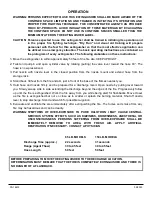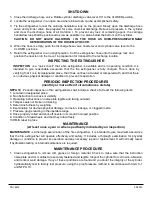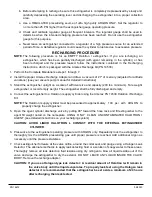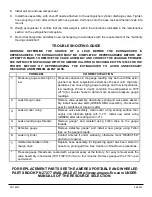
PN 16672
04/2020
OPERATION
WARNING:
PERSONS EXPECTED TO USE THIS EXTINGUISHER SHALL BE MADE AWARE OF THE
CONFINED SPACE LIMITATIONS AND TRAINED IN INITIATING ITS OPERATION AND
PROPER FIRE FIGHTING TECHNIQUE. THE CONCENTRATED AGENT CAN PRODUCE
TOXIC BY
-
PRODUCTS. AVOID INHALATION OF THESE MATERIALS BY EVACUATING
THE CONFINED SPACE. DO NOT USE IN CONFINED SPACES SMALLER THAN THE
MINIMUM STATED ON THE EXTINGUISHER LABEL.
CAUTION:
Persons expected to use this extinguisher shall be trained in initiating its operation and
in the proper fire fighting technique. "Dry Run" and visual aid training will prepare
personnel with the feel for this extinguisher so that the most effective application can
be utilized in an emergency situation. The basic operating instructions are contained on
the pictogram of every extinguisher. The following elaborates on these instructions:
1.
Move the extinguisher to within approximately 50 feet of the fire site. KEEP UPRIGHT.
2.
Twist and pull pin and open cylinder valve by rotating (pulling) the valve lever toward the hose 90°. The
hose is now pressurized.
3.
Pull nozzle with nozzle lever in the closed position from the nozzle mount and extend hose from the
storage rack.
4.
Stand back 30 feet from the fire and aim just in front of the base of the flames nearest you.
5.
Hold hose and nozzle firmly and be prepared for a discharge recoil. Open nozzle by pulling lever toward
you. Slowly sweep side to side extending the discharge beyond the edges of the fire. Progressively follow
up until the fire is extinguished. Work the fire away from you while being alert for flashbacks. Move closer
as the fire is extinguished but not so close as to scatter or splash the burning material. Shut off nozzle
lever to stop discharge. Stand and watch for possible re
-
ignition.
6. Evacuate and ventilate the area immediately after extinguishing the fire. The fumes and smoke from any
fire may be hazardous and can be deadly.
WARNING:
SYMPTOMS OF OVER
-
EXPOSURE TO PURE HALOTRON l MAY CAUSE CENTRAL
NERVOUS SYSTEM EFFECTS SUCH AS DIZZINESS, DROWSINESS, ANESTHESIA, OR
UNCONSCIOUSNESS. PERSONS SUFFERING FROM OVER
-
EXPOSURE SHALL BE
IMMEDIATELY REMOVED TO AREA WITH FRESH AIR. APPLY ARTIFICAL
RESPIRATION IF NECESSARY. CONTACT A PHYSICIAN
.
65 LB. MODELS
150 LB. MODELS
Discharge Time (approx.)
22 seconds
31 seconds
Range (Agent Thow)
30 to 45 feet
30 to 45 feet
Hose Length
50 feet
50 feet
BEFORE PREPARING TO MOVE THE EXTINGUISHER TO THE RECHARGE LOCATION,
DETERMINATION MUST BE MADE THAT THE FIRE IS COMPLETELY EXTINGUISHED AND THERE IS
NO DANGER OF A FLASHBACK.








